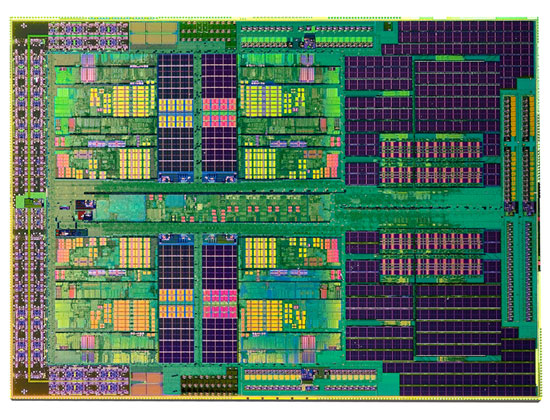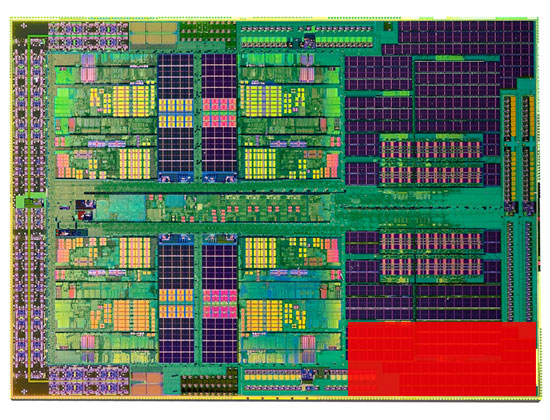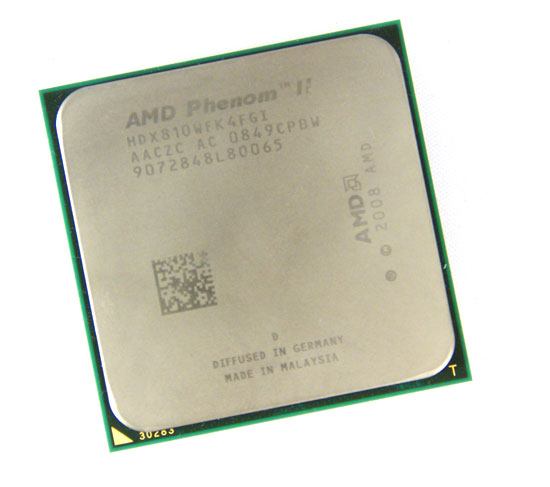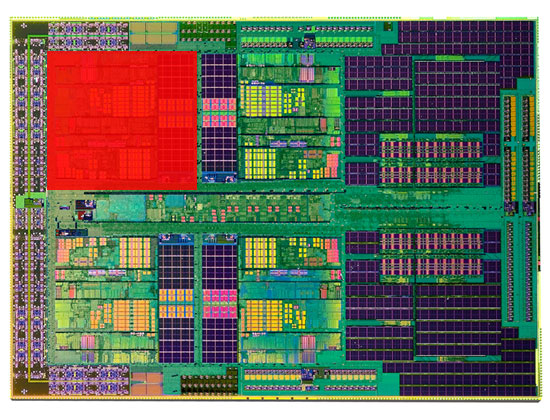The Phenom II X4 810 & X3 720: AMD Gets DDR3 But Doesn't Need It
by Anand Lal Shimpi on February 9, 2009 12:00 AM EST- Posted in
- CPUs
We're in the midst of a price war folks, and at a time when the global economy is looking a little shaky this actually works very well for us. Let's recap what's happened.
AMD launched its first truly competitive CPUs in over two years in January: the Phenom II X4 940 and 920. Priced at $275 and $235 respectively, these two chips beat out the equivalently priced Intel CPUs, the Q9400 and the Q8200. If you haven't already, I would strongly suggest reading that article in order to get the background information necessary about what was changed in Phenom II to make it so competitive.
Less than two weeks later Intel responded by cutting its quad core prices. The table below shows what happened:
| Processor | Dec '08 Price | Jan '09 Price | % Decrease |
| Intel Core 2 Quad Q9650 (3.00GHz) | $530 | $316 | 40% |
| Intel Core 2 Quad Q9550 (2.83GHz) | $316 | $266 | 16% |
| Intel Core 2 Quad Q9400 (2.66GHz) | $266 | $213 | 20% |
| Intel Core 2 Quad Q8300 (2.50GHz) | $224 | $183 | 18% |
| Intel Core 2 Quad Q8200 (2.33GHz) | $193 | $163 | 16% |
AMD responded immediately, cutting its Phenom II prices to match:
| Processor | Launch Price | New Price | % Decrease |
| AMD Phenom II X4 940 (3.0GHz) | $275 | $225 | 18% |
| AMD Phenom II X4 920 (2.8GHz) | $235 | $195 | 17% |
We really have to applaud both companies here. Intel for responding so quickly and effectively; the 40% price drop on the Q9650 just made sense and now you can have a chip with 12MB of L2 cache for under $300 thanks to the Q9550. And we have to thank AMD for keeping the pressure on and making this possible.
The Phenom II X4 940 is once more priced similar to the Core 2 Quad Q9400, while the 920 is sort of in between a Q8300 and a Q9400. Based on last month's article we know that the Phenom II X4 940 is a better buy than the Core 2 Quad Q9400, but the 920 is a tougher sell compared to the Q8300/Q9400.
Phenom II: Now in Three Flavors
Things get more complicated with today's announcement; AMD is launching no less than five new Phenom II CPUs. Their specs and model numbers are below:
| Processor | Clock Speed | un-core Clock | L2 Cache | L3 Cache | TDP | Price |
| AMD Phenom II X4 940 | 3.0GHz | 1.8GHz | 2MB | 6MB | 125W | $225 |
| AMD Phenom II X4 920 | 2.8GHz | 1.8GHz | 2MB | 6MB | 125W | $195 |
| AMD Phenom II X4 910 | 2.6GHz | 2.0GHz | 2MB | 6MB | 95W | $??? |
| AMD Phenom II X4 810 | 2.6GHz | 2.0GHz | 2MB | 4MB | 95W | $175 |
| AMD Phenom II X4 805 | 2.5GHz | 2.0GHz | 2MB | 4MB | 95W | $??? |
| AMD Phenom II X3 720 BE | 2.8GHz | 2.0GHz | 1.5MB | 6MB | 95W | $145 |
| AMD Phenom II X3 710 | 2.6GHz | 2.0GHz | 1.5MB | 6MB | 95W | $??? |
| AMD Phenom 9950 | 2.6GHz | 2.0GHz | 2MB | 2MB | 140W | $173 |
The Phenom II X4 910 is just a lower clocked version of the CPUs we reviewed last month. The 800 series is a bit more unique, albeit not in a good way. The 900 series all have 2MB of L2 cache on die and a 6MB L3; the 800 shrinks the L3 down to 4MB. If you remember back to our original Phenom II article I argued that a big reason for the original Phenom's failure was that it didn't have a large-enough L3 cache. With a 6MB L3 the 900 series seemed like a good balance between L2 and L3 cache size, but going any smaller than 6MB could prove to be overly detrimental to performance. Also keep in mind that Intel's Ronak Singhal was adament that Nehalem shouldn't have any less than an 8MB L3 (or 2MB per core), even the mainstream Core i7 derivatives are slated to have 2MB of L3 cache per core (4MB for the dual-core versions).

A Phenom II X4 900 series die: 258mm2, 4-cores and a 6MB L3 cache
The 800 series is simply an example of die harvesting. Some of the die have too many defects in the L3 cache, but fully functional cores. Instead of throwing away these CPUs AMD turns them into the Phenom II X4 800 series. While physically the same die size and transistor count of the 900 series, these chips simply have some of the L3 cache disabled:

A Phenom II X4 800 series die: 258mm2, 4-cores and a 4MB L3 cache

We've also got the Phenom II X3 720 and 710. These are both triple-core derivatives, once again they are physically the same die as the Phenom II X4 900 series, but this time with only 3 cores enabled. These are further harvested parts used simply to improve yields. I suspect that between the Phenom II 900, 800 and 700 series AMD is able to use as much of a single wafer as possible, all through harvesting and by targeting different price points. Note that this is a smart strategy to compete with Intel because Intel's 45nm yields are already quite mature, thanks to a year-long head start.

A Phenom II X3 700 series die: 258mm2, 3-cores and a 6MB L3 cache
As yields improve over time you can expect some of these parts to go away. But for now, AMD basically has a single Phenom II die that it's selling three different ways.
The 700 series is arguably one of the best harvested Phenom II parts AMD has since it retains the 6MB L3 cache of the 900 series. With 2MB of L3 cache per core, this bests even the 900 series.
When AMD produces a Phenom II die if part of the L3 is bad, it gets disabled and is sold as an 800 series chip. If one of the cores is bad, it gets disabled and is sold as a 700 series chip. If everything is in working order, then we've got a 900.










77 Comments
View All Comments
hyc - Monday, February 9, 2009 - link
I was looking for the test that justified the "DDR3 not worth it" conclusion, but didn't see it.Where did you show the results of testing the X4 910 against the X4 940, with CPU and NB clocks set identically? If you didn't test this, then how can you make any conclusion about DDR2 vs DDR3 performance on Phenom II? If I missed it, sorry for being blind.
7Enigma - Monday, February 9, 2009 - link
I'm hoping since this just went up they forgot to include a couple pages. If not, hopefully they are retesting ASAP to include data....jchan2 - Monday, February 9, 2009 - link
i'm intersted in seeing the benchmarks myself.if it's true that DDR2 vs DDR3 doesn't make much difference in performance, then what's the purpose of getting DD3?
TheFace - Monday, February 9, 2009 - link
So that when the prices DO drop later this year, they aren't caught with their pants down playing catch up on the memory compatibility front. Also, when Joe Schmoe runs to Worst Buy to replace the computer that he got 5 years ago, with a new $600 model, he can look on the box and see DDR3 which MUST be faster than DDR2.It's a selling point. In retail, ANYTHING is a selling point as long as there is a disparity in knowledge held by the parties involved.
Targon - Monday, February 9, 2009 - link
Compatibility. When Intel made the jump to DDR2, AMD waited until the prices came down on the memory. If there is no performance advantage, then the only reason to change memory types is for price reasons.For large OEMs like Dell, HP, and Gateway, it is more cost effective if all systems use the same type of memory. At this point though, since there is a price premium for DDR3 memory, just having DDR3 support on the CPU would not make an OEM add more AMD based machines to their list of systems sold.
Gary Key - Monday, February 9, 2009 - link
We are still working on the comparison, but all of the initial numbers pointed to a tie between DDR3 and DDR2 in our results so far. The BIOS releases for the AM3 boards are just now coming up to speed. I had planned on significantly more information in the overclocking section but we just received a new BIOS for the 790FX boards that allow DDR3 clocking above 1600 or so.However, at like core clock speeds, DDR2-1175 C5 is just as fast as DDR3-1600 C7 in most of the benchmarks at this point. We are running tests now at the lower end of the spectrum to show 800/1066 DDR2 vs 1066/1333 DDR3. Those results still show little if any differences.
thepiratebay - Wednesday, February 25, 2009 - link
Intel Core i7 920 Nehalem 2.66GHzin ur upper test as u can seee 2.8?????
Enoc - Tuesday, February 10, 2009 - link
DDR3 is not the problem, Deneb is bottlenecked on NB-L3 side... what it needs is NB at 2,800mhz+ with DDR3 1,600mhz+ for a good scaling...Denithor - Monday, February 9, 2009 - link
"We are still working on the comparison"SO - why would you even reference DDR3 as being useless in your title if you aren't going to provide evidence to back up this comment?
Gary Key - Monday, February 9, 2009 - link
We are still working on it but all results so far point to that being the case right now. It is difficult to have meaningful results ready when receiving BIOS releases that actually stabilize a board just a few hours before going to print. ;)